Feeling the Pull
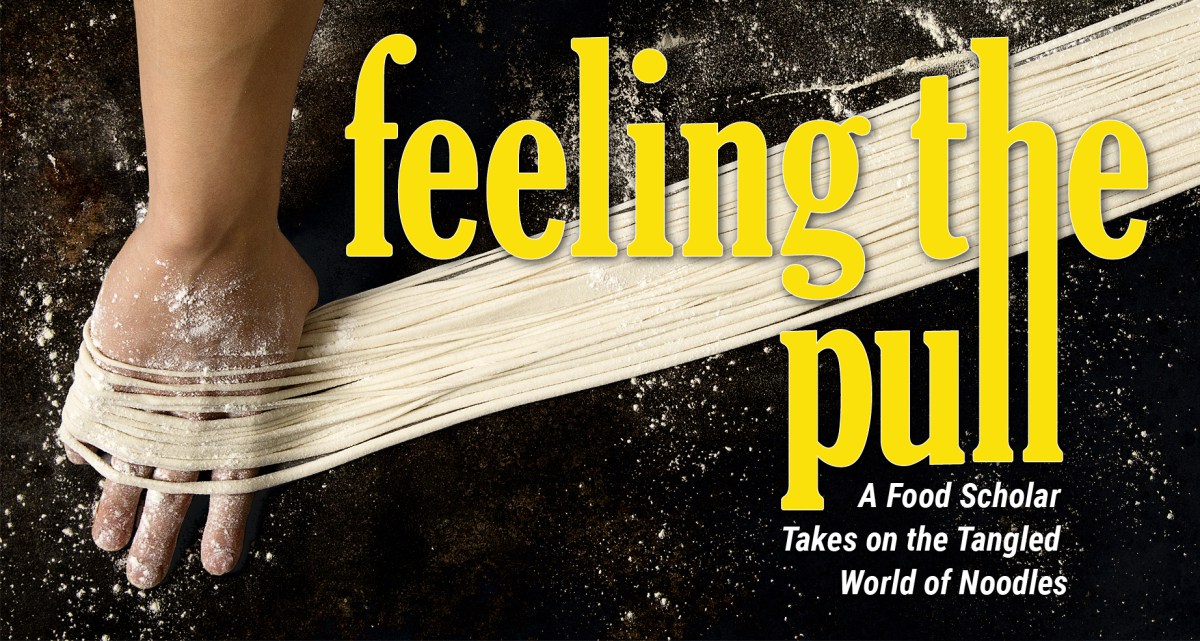
01
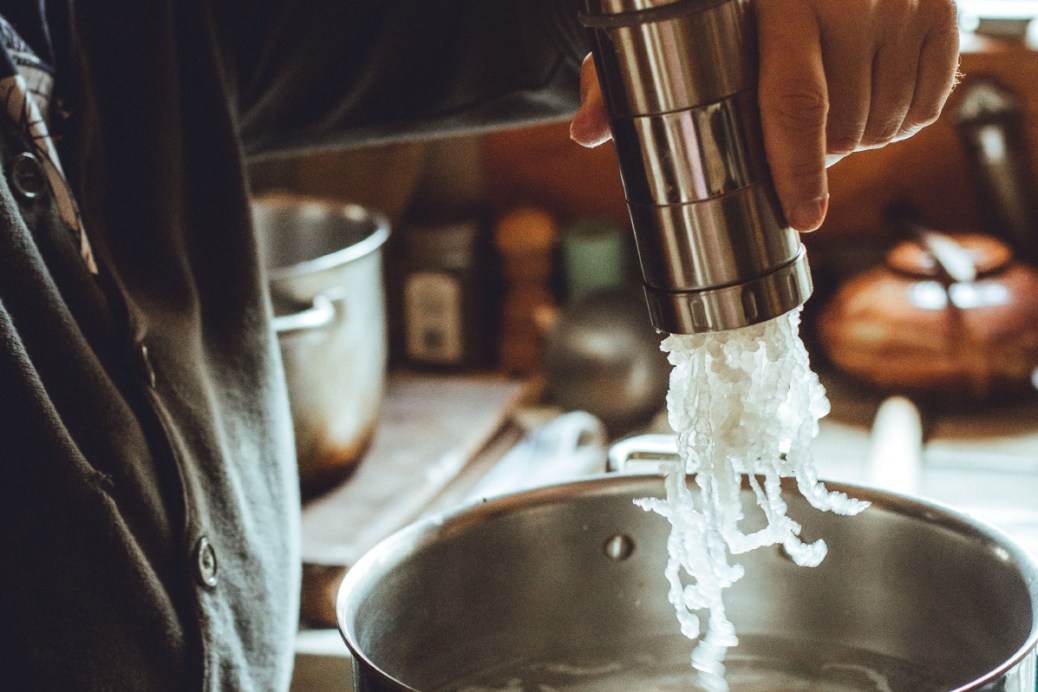
A Chemistry Experiment
Ken Albala squeezed cloudy, spaghetti-size shirataki noodles into a pot of boiling water. They emerged from the hand-held metal extruder jagged and translucent.
We were on the first recipe of a marathon day of noodle making and he wanted to start with the strangest one.
“Isn’t it bizarre?” Albala asked, peering down into the pot filled with some of the weirdest-looking noodles I’d ever seen. “It looks like some nasty chemical, but it’s not.”
Shirataki noodles are traditionally from Japan and have been around for centuries. And they are bizarre: Made from konjac flour, which is derived from Amorphophallus plant roots, they are indigestible, so they fill you up but have no caloric value (a fact, Albala suspects, that the original consumers of shirataki did not know). Albala keeps a large vitamin bottle filled with konjac flour in his Stockton, California, home, a few blocks from University of the Pacific, where he is a history professor and chair of food studies. Just 1 1/2 tablespoons of konjac flour—which contains a polysaccharide called glucomannan that acts as a hydrocolloid, which means that it adds viscosity to water—makes a potful of noodles.
These noodles had come together by mixing the konjac flour with water and then, after allowing the mixture to rest, adding calcium hydroxide, an alkaline that raises the pH of the noodle dough and is necessary to help turn it into a solid gel.
“This is entirely a chemistry experiment,” Albala said as he set the timer for 30 minutes, an unbelievable amount of time to boil a noodle. And for Albala, noodles are the perfect grounds for experimentation. “It’s so much more fun to just go get in the kitchen and play around. If it doesn’t work, so the hell what? Every time you experiment, it’s a learning experience.”
We tasted this extreme noodle after it finished cooking, sampling straight from the pot with chopsticks. Albala declared the texture perfect. And they were quite pleasing—flavorless but slick and snappy with a toothsome bite. All the rest of the noodles we would make that day, Albala assured me, followed a much more standard science to make it to our bowl.
02
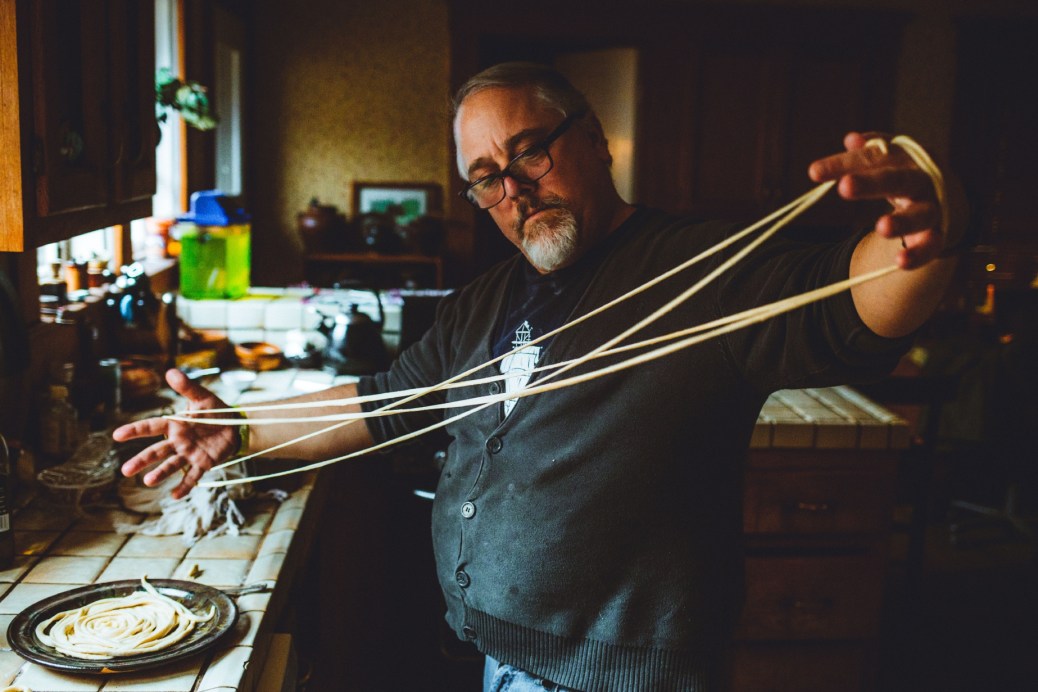
A Noodle Obsessive
Albala is, perhaps, one of the best-known, and most prolific, food historians in academia today. He is known as a charismatic teacher who has written 24 academic books on different topics in food studies, ranging from beans to pancakes to Eating Right in the Renaissance. (He came to the field of food studies when looking for a topic for his history dissertation at Columbia and found himself drawn to food culture during the Renaissance.) He founded the food studies master’s degree program at the University of the Pacific’s San Francisco campus and has been called upon as an expert in food history and culture for publications such as The New York Times and The Guardian.
“He combines two aspects: the social, cultural and historical analysis, and he also cooks extensively,” says Dr. Krishnendu Ray, department chair of food studies at New York University and president of the Association for the Study of Food and Society. “In that way, he is more than a culinary historian—he bridges the academic world with good cooking, with the public in view. He’s incredibly rare.”
Albala became interested in noodles in the summer of 2014, when he taught at Boston University’s gastronomy program. While there, he began making noodle soups for breakfast—albeit with store-bought noodles, but the obsession was sparked. When he returned home to California, he decided to try making his own noodles, in his better-stocked kitchen, from scratch. Soon he was translating noodle recipes from old cookbooks and eating every handmade noodle he could find on his many academic trips around the globe. He re-created many of these recipes and techniques at home—and, often, riffing on them with his own variations—posting photos of his efforts to his blog and social media.
Not all are traditional. Albala’s noodles have ranged from kabocha macaroni to a Hipster Chia Noodle Blackberry Cocktail to noodles made with cricket flour. In a blog post on December 19, 2014, titled Candy Noodle Soup, he published a photo of thick noodles swimming in a broth studded with colorful bits. “This came to me in a dream. Noodles made of marzipan. A broth of Mexican chocolate with a little booze for sheen, piped in with a turkey baster. Garnished with sprinkles, candied citron, and peppermint bark. It comes together rather well. Sort of tastes like Mozart Kugeln.”
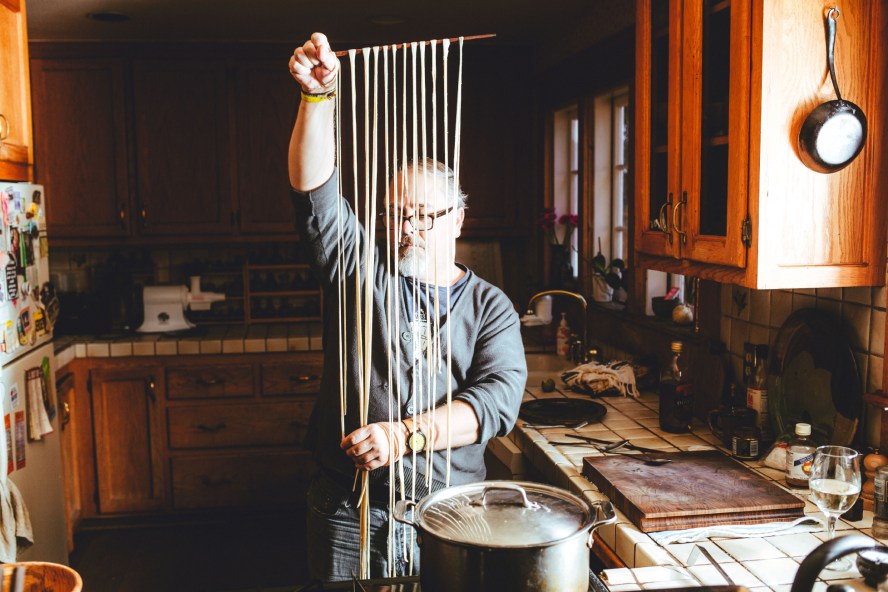
Albala’s next book—Noodle Soup: Technique, Theory, Obsession—is slated to come out from the University of Illinois Press in 2017. It’s not his first book written specifically for the lay audience, but it’s the first, he says, that isn’t about food that is “difficult or dangerous that no one has done before at home.”
His goal? “To get people into the kitchen,” he said. “I’ve been writing all these academic, stuffy books, but what I want is for people to go into the kitchen and cook and have fun and experiment and stop eating garbage.”
03
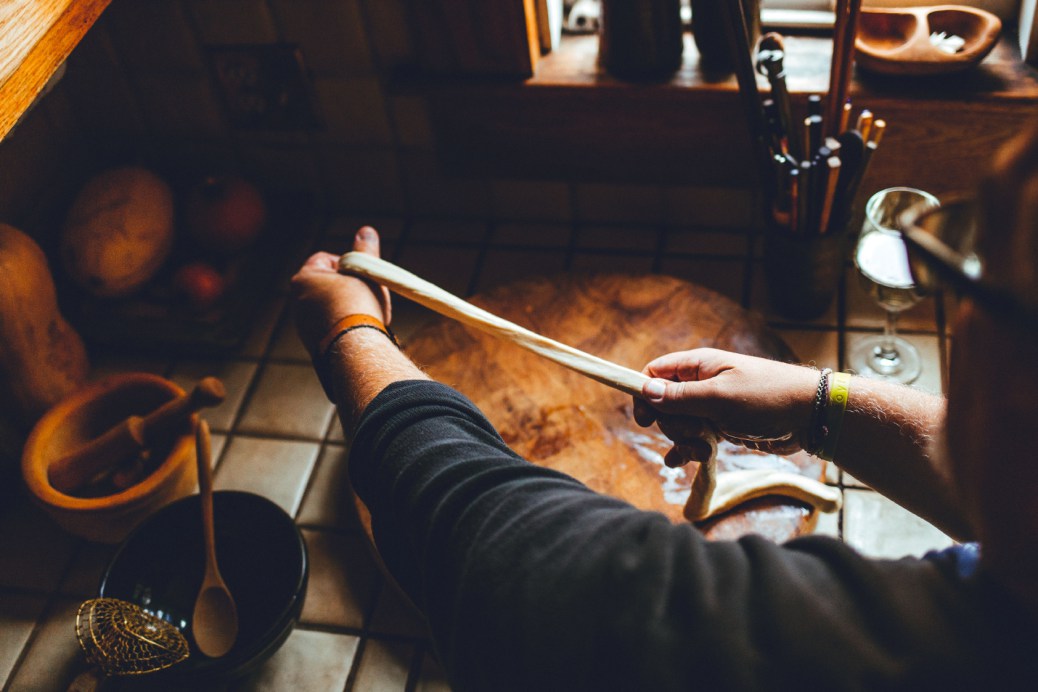
Push and Pull
Next up in our noodle-making afternoon, Albala picked up a ball of dough that had been resting on the counter, covered in plastic wrap, since I arrived. It was the dough for hand-pulled noodles—the kind that can be found in far eastern Europe and northern China. These noodles all come from the same family of lamian noodles believed to be spread by the Mongols “when they conquered everything in 1344,” Albala explained.
It all starts with the flour. And this time, not quirky konjac flour, but traditional white wheat flour.
White wheat flour is made from ground-up wheat berries, minus the outer husk, germ, and bran. As food scientist Kelly Connelly later explained, this flour contains two proteins, called glutenin and gliadin, that, when hydrated, form a loose network called gluten. This is what gives structure to loaves of bread, muffins and cookies, and, of course, some of the world’s most popular noodles: Italian pastas, Japanese ramen noodles, and Chinese hand-pulled noodles. Gluten forms as soon as wheat flour is hydrated, during the mixing process, so wheat-flour dough has structure before it is cooked. (Wheat starch, on the other hand, is what’s left when the gluten is removed. Starches—whether from wheat, potatoes, or corn—provide structure to a noodle by becoming hydrated and then gelatinizing with heat. Without gluten, starch noodles lack structure until they are cooked.)
The hand-pulled noodle recipe calls simply for high protein (and therefore high gluten) bread flour—the better to strengthen the noodle for stretching—that forms a dough with water and a little salt.
Albala had woken up early and made and kneaded the dough, so that it could rest for at least six hours. This resting period further prepares the dough for stretching because, during this time, natural enzymes present in the wheat flour begin to break down some of the gluten proteins, allowing the gluten network to relax.
While the recipes for making hand-pulled noodle dough are all basically the same around the world, regional differences can be seen especially in how the noodles are shaped. “There is one place in China where it’s just one long noodle coiled up in a basket and a guy just pulls it out and throws it in the pot,” said Albala. This long, continuous coil is meant to represent the beginning and end of one long, continuous life. Noodle as metaphor, and one reason hand-pulled noodles are popular around the new year.
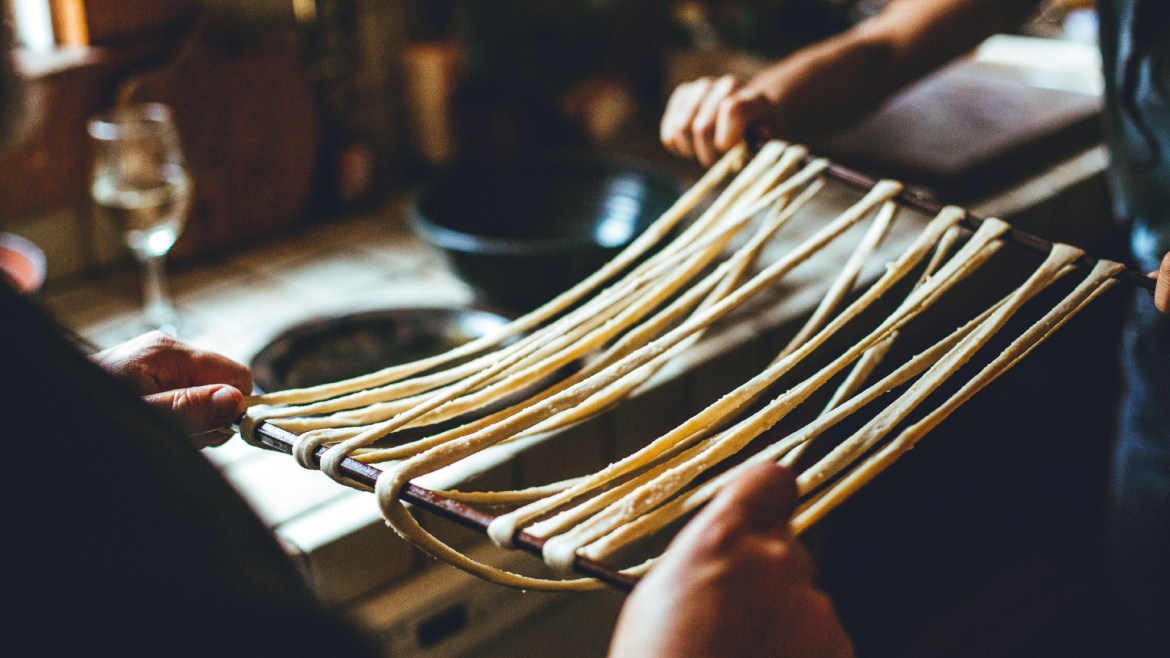
Albala demonstrated how to pull and twist the softball-size mound, with the goal of shaping it into a continually thinner and longer noodle. He only pulled it a few feet in length before it broke into pieces, which he continued to lengthen and stretch into individual noodles.
Once the dough began to take on a slightly rough texture from the pulling, he mixed together a large bowl of water with less than a twelfth of a teaspoon of alkaline liquid made by the brand Koon Chun, which is widely used for noodle making and available in Asian grocery stores. He lightly dipped his hands into the bowl before he shaped the noodle, allowing the thin surface-coating of alkali to make the noodle both stronger and just a bit more slippery.
Why alkali? Alkali interact with the gluten proteins to make the noodle firmer. “This is not that well understood, but apparently the bonding between gluten molecules becomes stronger under alkaline conditions,” wrote food scientist and writer Harold McGee in his treatise on alkalinity in noodles for the magazine Lucky Peach. However, too much of an alkali can turn a noodle from uniquely pleasant to caustic or odoriferous.
Albala does note that alkalis need to be used carefully, as they can affect the taste of the noodle, making it soapy. “The flavor of alkaline noodles is really distinctive, and that’s as big a mystery as anything,” McGee wrote. “It’s a little bitter, but mostly it’s a soapy kind of feeling.”
Albala dipped his hands into the alkaline water and pulled, eventually ending up with rows of thick, rough-looking—but, he assured me, perfectly edible—noodles that he placed one at a time in the boiling water. He and his son once pulled a single noodle to almost 200 feet, Albala said. He worked on his form by watching hours of videos in Russian, but added that there are many different ways to shape these noodles—in China some wrap them around chopsticks, while other noodle masters look like they are jumping around the room.
“Once, I saw a lady in Bratislava doing this on the street,” he said, referring to his method. “Little bits, stretching and ripping them in half, just like we did. And I was standing there staring in amazement, and the woman was like, ‘Are you going to buy some or not? What’s the big deal? I’m making noodles, you idiot!’ ” He laughed.
“They were delicious,” he added.
And when the noodles came out of the boiling water a few minutes later, they were, in fact, quite good. The flavor was similar to traditional wheat noodles, but with a chewiness and a slight slipperiness to them.
04
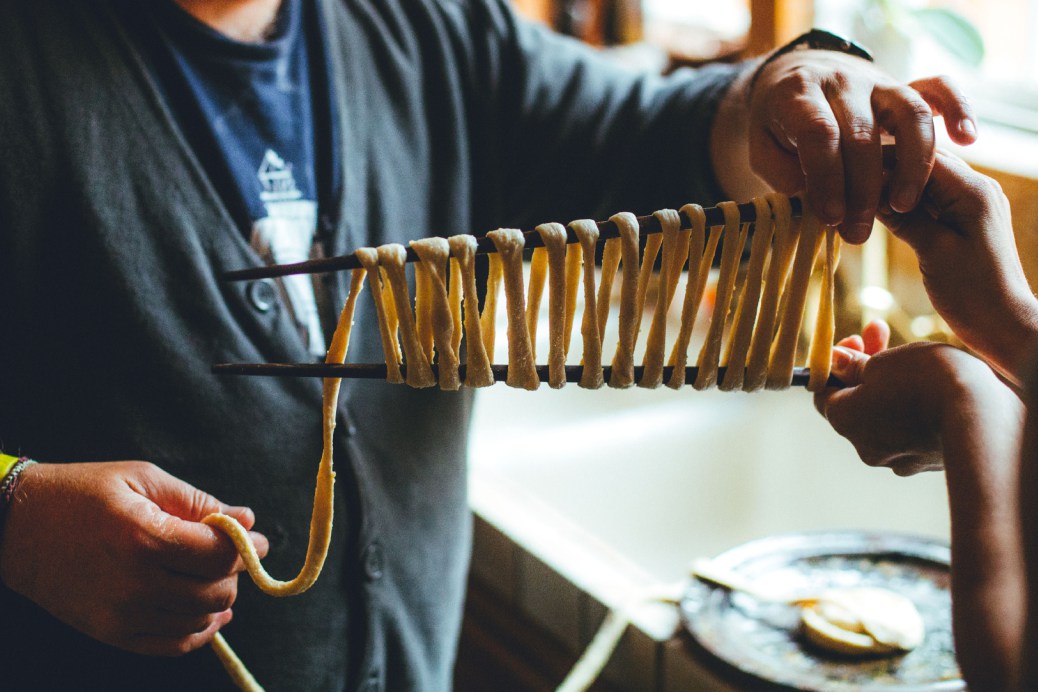
Embrace the Blur
Different types of noodles were developed in cultures around the globe, all at about the same time, with the earliest references in cookbooks found around the third century. Home cooks had certainly been making noodles long before then, using ingredients that could be sourced locally. “The funny thing is, they are almost using the same ingredients in Italy and China,” Albala said. In warmer, humid areas there is rice and, often, rice noodles; in places where wheat can be grown, wheat noodles are prevalent. The extraction of starches from tubers or rice or wheat—also common bases of soup noodles—were variations developed from available ingredients.
Local ingredients were not the only influence: While a slippery texture and long noodles are often favored in Asian cuisine, noodles (for soup) tend to be shorter in Italian cuisine, in part because Italians were eating with spoons and not chopsticks. Also, slurping noodles is considered rude across Europe. Alternately, in Japan, this is considered necessary. (There is some science there. Slurping cools down the noodles, firming up the texture and increasing chewiness. It also brings in some air over the noodles, oxidizing some of the subtle flavor compounds and increasing their flavor.)
He began sifting through his cupboards filled with flours and starches, remnants of his experiments, for the ingredients for our final noodle: a wheat and egg noodle considered more of a classic Italian noodle.
He took me to his collection of dried vegetable and herb powders in jars on a shelf in a corner of his kitchen. Albala has experimented with different versions of flavored noodles, adding dried and ground vegetables or herbs to the dough. He had been playing with various noodle and broth combinations: marbleized tomato and olive noodles; pickled Meyer lemon noodles; and a “salad noodle soup” made with noodles flavored with lettuce, tomato, celery, carrot, red cabbage, and cucumber. The dehydrator that had been humming in the corner of the small kitchen all morning contained drying carrots, cabbage, and persimmons, all potential ingredients for future noodles. “Last week I made noodles with 50 percent dehydrated chard. They were incredibly dark green in color and tasted . . . like too much,” he said.
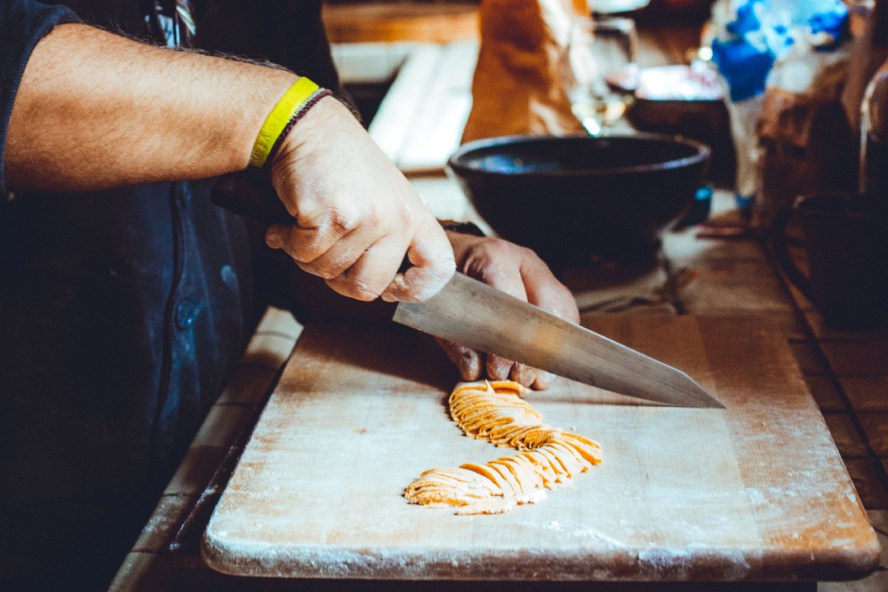
For this batch, he settled on dandelion from his yard and kabocha squash from the farmers’ market. He eyeballed about a cup of wheat flour and dried vegetable powder, putting them into a bowl, and added an egg, mixing it together with a fork until it could be handled. While Albala will offer specific ratios in Noodle Soup, he wants to also teach his readers to adjust to and experiment with what ingredients they might have on hand.
“The Chinese, the Italians, and the Arabs have all claimed that they were the first ones to invent noodles,” wrote Gary Hou, technical director of the Wheat Marketing Center, in his book, Asian Noodles: Science, Technology, and Processing. Each culture has its own expectations and mores around noodle making and eating. But Asian noodles—and ramen in particular—have become increasingly popular in the past fifteen years around the globe, causing these cultural rules to blur.
Albala embraces the blur. Were the noodles we were making Italian? Was the broth Chinese? Even though they were made from ingredients sourced mostly local to Central California? It didn’t matter, Albala said. They would be delicious. And that was the point.
Next week on Cook’s Science, we try our hand at our own recipe for hand-pulled noodles. Stay tuned!
Field Photography by Pete Lee.
Styled Food Photography by Steve Klise.
Food Styling by Marie Piraino.